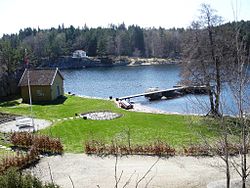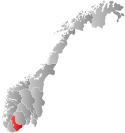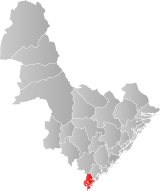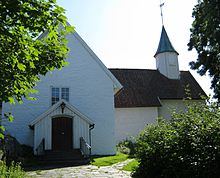Høvåg
Høvåg Municipality
Høvåg herred | |
|---|---|
| Høvaag herred (historic name) | |
 View of coastal Høvåg | |
 Aust-Agder within Norway | |
 Høvåg within Aust-Agder | |
| Coordinates: 58°10′11″N 08°14′50″E / 58.16972°N 8.24722°E | |
| Country | Norway |
| County | Aust-Agder |
| Established | 1 Jan 1865 |
| • Preceded by | Vestre Moland Municipality |
| Disestablished | 1 Jan 1962 |
| • Succeeded by | Lillesand Municipality |
| Administrative centre | Høvåg |
| Area (upon dissolution)[1] | |
| • Total | 77 km2 (30 sq mi) |
| Population (1962) | |
| • Total | 1,330 |
| • Density | 17/km2 (45/sq mi) |
| Demonym | Høvding[2] |
| Official language | |
| • Norwegian form | Bokmål[3] |
| Time zone | UTC+01:00 (CET) |
| • Summer (DST) | UTC+02:00 (CEST) |
| ISO 3166 code | NO-0927[5] |
Høvåg (historically: Høvaag) is a former municipality in the old Aust-Agder county in Norway. The 77 km2 (30 sq mi) municipality existed from 1865 until its dissolution in 1962. It was located in the southern part of the present-day municipality of Lillesand which is now in Agder county. The administrative centre of the municipality was the village of Høvåg where the Høvåg Church is located. Old coastal settlements in Høvåg include Ulvøysund, Gamle Hellesund, Skottevik, Kjøbmannsvig and Åkerøyhamn. The village of Høvåg is located midway between the towns of Lillesand and Kristiansand.[1]
History
[edit]The municipality of Høvaag was created in 1865 when the municipality of Vestre Moland was split into two separate municipalities: Høvåg (population: 2,069) in the south and Vestre Moland (population: 2,167) in the north. During the 1960s, there were many municipal mergers across Norway due to the work of the Schei Committee. On 1 January 1962, the municipality of Høvåg (population: 1,330) was merged with the neighboring municipality of Vestre Moland (population: 2,454), the ladested of Lillesand (population: 1,041), and the Gitmark farm area of Eide (population: 22). Together, these areas formed a new, larger Lillesand municipality.[6]
Name
[edit]The municipality (originally the parish) is named after the old Høvaag farm (Old Norse: Høyvágar). The first element is høy which means "hay". The last element is the plural form of vágr which means "bay" or "inlet". This is likely because the land along the bay is the site of lush vegetation.[7] On 21 December 1917, a royal resolution enacted the 1917 Norwegian language reforms. Prior to this change, the name was spelled Høvaag with the digraph "aa", and after this reform, the name was spelled Høvåg, using the letter å instead.[8][9]
Government
[edit]During its existence, this municipality was governed by a municipal council of directly elected representatives. The mayor was indirectly elected by a vote of the municipal council.[10]
Municipal council
[edit]The municipal council (Herredsstyre) of Høvåg was made up of 17 representatives that were elected to four year terms. The tables below show the historical composition of the council by political party.
| Party name (in Norwegian) | Number of representatives | |
|---|---|---|
| Labour Party (Arbeiderpartiet) | 2 | |
| Conservative Party (Høyre) | 3 | |
| Christian Democratic Party (Kristelig Folkeparti) | 2 | |
| Centre Party (Senterpartiet) | 3 | |
| Liberal Party (Venstre) | 7 | |
| Total number of members: | 17 | |
| Party name (in Norwegian) | Number of representatives | |
|---|---|---|
| Conservative Party (Høyre) | 3 | |
| Christian Democratic Party (Kristelig Folkeparti) | 3 | |
| Farmers' Party (Bondepartiet) | 3 | |
| Liberal Party (Venstre) | 8 | |
| Total number of members: | 17 | |
| Party name (in Norwegian) | Number of representatives | |
|---|---|---|
| Labour Party (Arbeiderpartiet) | 2 | |
| Christian Democratic Party (Kristelig Folkeparti) | 3 | |
| Liberal Party (Venstre) | 6 | |
| Joint List(s) of Non-Socialist Parties (Borgerlige Felleslister) | 5 | |
| Total number of members: | 16 | |
| Party name (in Norwegian) | Number of representatives | |
|---|---|---|
| Labour Party (Arbeiderpartiet) | 1 | |
| Christian Democratic Party (Kristelig Folkeparti) | 3 | |
| Liberal Party (Venstre) | 6 | |
| Joint List(s) of Non-Socialist Parties (Borgerlige Felleslister) | 6 | |
| Total number of members: | 16 | |
| Party name (in Norwegian) | Number of representatives | |
|---|---|---|
| Labour Party (Arbeiderpartiet) | 2 | |
| Joint list of the Liberal Party (Venstre) and the Radical People's Party (Radikale Folkepartiet) | 7 | |
| Joint List(s) of Non-Socialist Parties (Borgerlige Felleslister) | 6 | |
| Local List(s) (Lokale lister) | 1 | |
| Total number of members: | 16 | |
| Party name (in Norwegian) | Number of representatives | |
|---|---|---|
| Labour Party (Arbeiderpartiet) | 2 | |
| Conservative Party (Høyre) | 3 | |
| Liberal Party (Venstre) | 5 | |
| Local List(s) (Lokale lister) | 6 | |
| Total number of members: | 16 | |
| Note: Due to the German occupation of Norway during World War II, no elections were held for new municipal councils until after the war ended in 1945. | ||
Attractions
[edit]Høvåg Church
[edit]
Høvåg Church (Høvåg kirke) is located in Høvåg parish in Vest-Nedenes prosti. It is constructed of brick and was built ca. 1100 - 1150. The church uses a cruciform floor plan and has 400 seats. Nave is shaped like a T with the altar in the center. In 1723, the congregation started a project to expand, maintain and refurbish the church. The west wing was joined in 1768, the north wing, which is the current main entrance was built in 1828. The tower was built in 1831.[17]
The altarpiece is a triptych representing faith, hope, and love. It is from about 1620 and was completed by an unknown artist. The pulpit is from about 1660. Around 1900 the altarpiece was painted white, but in 1935 it was restored to the present form. The pictures on the pulpit is of the four evangelists.[18]
Notable people
[edit]- Karl Johan Fjermeros, a local politician
See also
[edit]References
[edit]- ^ a b Thorsnæs, Geir, ed. (23 July 2015). "Høvåg – tidligere kommune i Aust-Agder". Store norske leksikon (in Norwegian). Kunnskapsforlaget. Retrieved 2 September 2017.
- ^ "Navn på steder og personer: Innbyggjarnamn" (in Norwegian). Språkrådet.
- ^ "Norsk Lovtidende. 2den Afdeling. 1932. Samling af Love, Resolutioner m.m". Norsk Lovtidend (in Norwegian). Oslo, Norway: Grøndahl og Søns Boktrykkeri: 453–471. 1932.
- ^ "Forskrift om målvedtak i kommunar og fylkeskommunar" (in Norwegian). Lovdata.no.
- ^ Bolstad, Erik; Thorsnæs, Geir, eds. (26 January 2023). "Kommunenummer". Store norske leksikon (in Norwegian). Kunnskapsforlaget.
- ^ Jukvam, Dag (1999). "Historisk oversikt over endringer i kommune- og fylkesinndelingen" (PDF) (in Norwegian). Statistisk sentralbyrå. ISBN 9788253746845.
- ^ Rygh, Oluf (1905). Norske gaardnavne: Nedenes amt (in Norwegian) (8 ed.). Kristiania, Norge: W. C. Fabritius & sønners bogtrikkeri. p. 155.
- ^ "Norsk Lovtidende. 2den Afdeling. 1917. Samling af Love, Resolutioner m.m". Norsk Lovtidend (in Norwegian). Oslo, Norway: Grøndahl og Søns Boktrykkeri: 1000. 1917.
- ^ Den Nye rettskrivning : regler og ordlister (in Norwegian). Kristiania, Norge: Den Mallingske Boktrykkeri. 1918.
- ^ Hansen, Tore; Vabo, Signy Irene, eds. (20 September 2022). "kommunestyre". Store norske leksikon (in Norwegian). Kunnskapsforlaget. Retrieved 1 January 2023.
- ^ "Kommunevalgene og Ordførervalgene 1959" (PDF) (in Norwegian). Oslo: Statistisk sentralbyrå. 1960. Retrieved 21 December 2020.
- ^ "Kommunevalgene og Ordførervalgene 1955" (PDF) (in Norwegian). Oslo: Statistisk sentralbyrå. 1957. Retrieved 21 December 2020.
- ^ "Kommunevalgene og Ordførervalgene 1951" (PDF) (in Norwegian). Oslo: Statistisk sentralbyrå. 1952. Retrieved 21 December 2020.
- ^ "Kommunevalgene og Ordførervalgene 1947" (PDF) (in Norwegian). Oslo: Statistisk sentralbyrå. 1948. Retrieved 21 December 2020.
- ^ "Kommunevalgene og Ordførervalgene 1945" (PDF) (in Norwegian). Oslo: Statistisk sentralbyrå. 1947. Retrieved 21 December 2020.
- ^ "Kommunevalgene og Ordførervalgene 1937" (PDF) (in Norwegian). Oslo: Statistisk sentralbyrå. 1938. Retrieved 21 December 2020.
- ^ "Høvåg kirke". Store norske leksikon. Retrieved 1 October 2016.
- ^ "Høvåg kirke". Den norske kirke. Retrieved 1 October 2016.
External links
[edit] Aust-Agder travel guide from Wikivoyage
Aust-Agder travel guide from Wikivoyage

